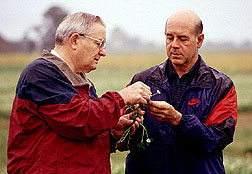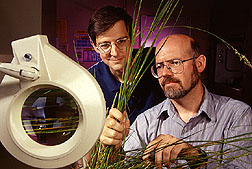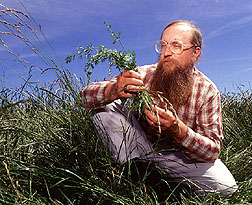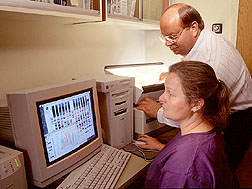Less Fire, More Science for Grass Growers
|
|
When you play with your children on the front lawn, feed your livestock on pasture, or play a round of golf with friends, you're likely enjoying a little bit of Oregon. That's because most of the nation's cool-season grass seed comes from the Pacific Northwest.
Farmers grew over one-half-billion pounds of grass seed in 1995—most in Oregon's Willamette Valley. Several species of ryegrass, fescue, and bluegrass make up most of the turf and forage crops.
But growing the seed is getting tougher. After this year, Oregon seed growers can use their most important farming tool—fire—only on a very limited acreage.
Field-burning each year after harvest controls weeds, removes leftover grass straw, and destroys diseases, including growers' nemesis, blind seed disease. Infected plants look normal, but many of the seeds won't germinate.
"Blind seed disease was inadvertently introduced, most likely from New Zealand, in the 1930s," says Agricultural Research Service plant pathologist Stephen C. Alderman. "By 1944, about 90 percent of the seed fields were infected, and only 13 percent of the seeds in some ryegrass crops germinated." Alderman works at the ARS National Forage Seed Production Research Center in Corvallis, Oregon.
"Burning fields between harvests completely controlled blind seed disease and is largely credited with saving the state's grass seed industry," Alderman says.
In 1995, grass seed ranked fifth in agricultural production for the state, worth $236 million.
Jack Pimm, a third-generation grass seed grower, heard his grandfather and father talk about blind seed disease when he was a child. But in 1995, he saw the devastation first hand in his field near Halsey, Oregon.
"Only 70 to 75 percent of the seed germinated. That was unheard of," he said. The seed was from Pimm's 1994 crop, grown in a field that had not been burned for 6 years. Through the Oregon State University Extension Service, Alderman heard of the problem and came in to help discover the cause.
"Sure enough, we had blind seed disease," Pimm says. To stop the disease in its tracks, he burned four of his fields and adopted new management techniques. Fortunately, Pimm was able to sell his seed—but at a substantial loss.
|
|
If field burning is so effective, why are growers phasing it out?
As the valley's population expanded in the 1960s, residents began to complain about the smoke-filled summer air. But it was a tragic accident that set the stage for changing growers' management practices.
"In 1988, smoke from a wildfire—believed to have started when the wind blew burning grass straw out of control—covered Interstate 5 south of Salem, Oregon," says David Nelson, executive secretary of the Oregon Seed Council. "A chain collision resulting in several deaths and injuries mobilized the industry, legislators, and the public to negotiate a phase-down of field-burning."
Before 1991, growers burned up to 250,000 acres per season in the valley. The allowable burned acreage has decreased incrementally since then and will be limited to 40,000 acres, plus up to 25,000 acres of steep terrain as identified by the Oregon director of agriculture.
Grass seed farmers in eastern Oregon, Washington, and Idaho may face similar restrictions in the future.
At first, growers worried that instead of diseases and weeds, their businesses would go up in smoke.
"The industry was very uncertain it would be able to make the change," Nelson says.
Alderman and other ARS, university, state, and private researchers are helping grass growers produce a viable seed crop.
"Now there's a feeling of confidence that we've solved enough of the problems to produce the same quality of grass seed without burning all our fields," Nelson says. "ARS has greatly helped the industry make that transition."
But the challenges are ongoing: the return of diseases, contamination of the seed crop by weeds, and a million tons of straw left each year after harvest.
ARS scientists are working hard on all three fronts. Alderman has monitored fields since 1988 to detect flare-ups of blind seed and ergot, another serious fungal disease that also destroys flowers and seeds.
"Early detection and treatment are very important to prevent the sudden increase and spread of diseases," he notes. No chemical treatments effectively control these diseases, but Alderman says specific plowing and planting techniques should keep them largely at bay without routine burning.
Two new lines of tall fescue will help growers combat another disease, stem rust. This rust attacks the stems and leaves, rather than the flowers, and can reduce seed yields by as much as 80 percent, says ARS plant pathologist Bill Pfender.
Growers spend nearly $27 million annually on fungicides to control stem rust on grass seed crops. The new tall fescue lines resist rust disease up to 10 times better than existing varieties. In laboratory tests, more than half of the plants from the new lines showed rust resistance, compared to only 5 percent of plants from older cultivars. ARS geneticist Reed E. Barker and plant pathologist Ronald E. Welty, who is retired, developed the fescue lines.
"Increasing the number of plants in a variety that are resistant to stem rust can stop or slow development of a disease epidemic," says Barker.
Managing Weeds, Certifying Seeds
|
|
Unlike most crops, grass is often its own worst weed.
"Grass plants are not neat and tidy like wheat or corn," says ARS agronomist George W. Mueller-Warrant. "Tillers and seeds on the same plant mature at different times, and there's no way the grower can get all the seed to the same ripeness simultaneously."
Growers time their harvest to get the best yield. But previously ripened seed heads that have shattered and tiny seeds that fall through the combine can mean that up to one-fourth of the total seed production lands back on the field.
"Many of the grass seed crops are perennial, and anything that germinates among the established plants is undesirable," Mueller-Warrant says.
The reasons are genetic. About half of Oregon's seed is produced under a certification process managed by Oregon State University.
To participate, growers submit requests for each field they want certified. Then the Certification Service reviews crop production records and conducts a series of field and laboratory evaluations. If the field meets the review criteria, it can be certified.
"The industry has more than 1,250 varieties of grass seed eligible for certification, and about half of those were in production in 1996," says Ronald Cook, head of the Oregon Seed Certification Service. "Our job is to ensure that the customers are getting the variety and product performance that they are expecting." Growers, in turn, can command higher prices for their seed and reach expanded markets by growing certified seed.
One obstacle to certification is genetic contamination.
If a seed falls off the grass plant and germinates, it is the progeny of the original plant. "These 'children' are weeds," says geneticist Barker. He notes that grass is wind-pollinated, so the parent and seedling are easily crossed. "This crossing may cause unwanted genetic shifts."
Cook says that in most crops, more than 1 or 2 percent genetic contamination can jeopardize certification. Barker is working with Cook to determine if these standards make sense from a genetic standpoint. Using molecular DNA markers, Barker is examining how much genetic shift is actually taking place.
But at least some shift is likely over time, so weed control will always be necessary.
"At the same time as the growers lost field burning, they lost several of the chemicals they were using on weeds," says Mueller-Warrant. He's studied over 20 alternatives to the herbicides that were not reregistered by the U.S. Environmental Protection Agency or that were taken out of production because of environmental concerns.
His tests show three as the most promising: oxyfluorfen, metolachlor, and pendimethalin. The first received an emergency registration under the trade name Goal in 1989. Mueller-Warrant says that chemical best controls a large flush of weeds germinating after heavy rains.
Metolachlor, known under the tradename Dual, was registered last year. The last and newest will be registered as Prowl.
"Pendimethalin will probably be the most useful for the grower. In field tests, it provided close to 100 percent control of seedlings with little crop injury," he says.
Biological control also looks promising for controlling annual bluegrass weeds in ryegrass and tall fescue crops and in cheatgrass or downy brome, a noncrop grassy weed infesting Kentucky bluegrass stands.
|
|
Retired ARS soil scientist Lloyd F. Elliott and colleagues in Corvallis and Pullman, Washington, have discovered weed-killing bacteria that live naturally among the plant roots.
"In laboratory and growth chamber tests, the bacteria provided virtually 100-percent control of the undesirable species," Elliott says. The bacteria are ready for field testing.
What To Do With Residue
While the burning phaseout increased weed and disease problems, it also gave growers an entirely new—and perhaps the toughest—challenge: managing 1 million tons of grass straw annually. After harvest, a blanket of plant stalks, or straw, covers the field. Burning eliminated the straw and stimulated regrowth of next year's crop.
Unless the straw is removed from the crowns of perennial grass plants, the crowns don't receive enough light, Elliott says.
Straw left on the field also limits herbicide effectiveness.
About a third of the straw can be sold for animal feed and bedding, but the supply far exceeds demand.
Elliott and ARS agricultural engineer Donald B. Churchill proved for the first time that low-input, on-farm composting of the high-carbon straw was possible. Their method involved gathering the straw in large windrows alongside the field and turning them three or four times with a tractor-mounted front-end loader.
"Before our experiments, it was believed that you would have to add nitrogen before the straw would decompose. There was also concern that the compost wouldn't reach high enough temperatures to kill weed seeds and inhibit diseases," Elliott notes.
Growers discovered that they could also leave the straw on the field to decompose in place, if they chopped it fine enough that the grass crowns weren't covered.
Another ARS research project addresses the variation in crop needs and environmental conditions across the Willamette Valley and drier grass-growing regions of the Pacific Northwest.
"The southern part of the valley has poorly drained soils that are very wet in winter," says ARS agronomist Jeffrey J. Steiner. He's coordinating a long-term sustainable cropping systems program with scientists from ARS, Oregon State University, and the U.S. Department of Agriculture's Natural Resources Conservation Service; extension specialists; and growers.
The south valley supplies most of the annual and perennial ryegrass seed. The moderately drained soils to the north allow more crop diversity, and growers farm tall fescue seed as a major crop. Well-drained hilly areas produce fine fescue seeds, but these soils erode easily if not managed properly.
In each of the three regions, Steiner and colleagues are looking at the best methods for managing straw (cutting and leaving on the field versus removing the straw), rotating crops (grass seed continuously or rotating grass with legume seed crops and wheat or meadowfoam), and planting methods (conventional or no-till).
|
|
"One of the main problems is how to rapidly establish each crop. Otherwise a grower can go as many as 20 months in the rotation sequence without an economic return," he says.
The first complete crop rotation will end this year. But the study has already provided valuable information for growers.
"Clover, which fixes nitrogen in the soil, is a good addition to both a ryegrass-spring wheat rotation on poorly drained soils and tall fescue on better drained soils," says Steiner. "By strategically growing alternative crops before the grass seed, we can break weed and disease life cycles."
Stephen M. Griffith, an ARS plant physiologist, also looks at nitrogen use in the seed crops. He and others have found that as long as chopped-up straw residue doesn't cover the growing crowns of the grass plants, it may help the crop in the long run.
"Over time, the residues contribute nitrogen to the soils," Griffith says. "We also have evidence that the microbial community and soil quality are improving underneath the straw," he adds.
Steiner says all these experiments should lead to establishing biological indicators of the health of the soil and crops. The goal, he says, is to help growers predict how their fields will react to specific management changes so they can maximize both economic and environmental benefits.
"The loss of field burning and chemicals required a major change in how growers produce their crops. We now have the opportunity to optimize all aspects of grass seed management," Steiner says. — By Kathryn Barry Stelljes, ARS.
The ARS scientists in this story can be reached at the USDA-ARS National Forage Seed Production Research Center, 3450 S.W. Campus Way, Corvallis, OR 97331-7102.











